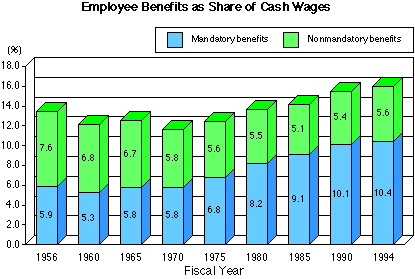
CUSTOM-MADE BENEFIT PLAN:
Growing Number of Firms to Give Employees a Choice
NOVEMBER 13, 1996
Correspondence Course Firm Leads the Way
The plan was first adopted in Japan in April 1995 by a company offering correspondence courses. Before then, the firm provided all qualifying employees the same benefits. Now, it gives them a menu along with 92 points a year--each point being worth around 1,000 yen (9 dollars at 110 yen to the dollar)--which they can use to receive the benefits they desire.
Twelve different benefit categories were initially offered, with ceilings being placed on the number of points that could be used for each. For instance, workers were allowed to use up to 40 points a year for housing subsidies and 20 for the company nursery. They could also use 4 points a day to have hospitalization fees subsidized and either 6 or 3 points a month for their individual pension plans--depending on whether their premiums were above or below 10,000 yen (91 dollars).
Starting this year, the list of categories were expanded to 18 to include such items as home nursing care and day-care services. Such improvements have given employees greater choice and have won the plan widespread acceptance.
In March 1996 a major retailing chain also adopted the cafeteria approach. It provides its employees 1,200 points a year, each worth about 50 yen (45 cents), with an additional 100 given for each dependent.
Twenty-two types of benefits are available, including day care at 61 points a month; complete medical checkup at 114 points; checkups for family members at 69 points; and the services of a visiting health worker at 63 points a day.
A distinguishing feature of both companies' plans is that they allocate the same number of points to all employees, regardless of age, gender, position, and years of service. They claim that all workers are individuals who should be entitled to the same benefits and who can decide for themselves what options they want most.
Corporate Advantages
Behind the growing interest in the cafeteria plan is the rise in the cost of providing employee benefits. According to a survey of 746 large companies conducted by Nikkeiren (Japan Federation of Employers' Associations), the cost of benefits averaged 82,169 yen (750 dollars) a month for each worker in fiscal 1994 (April 1994 to March 1995), 3.3% more than the previous fiscal year. The increase was higher than the 2.5% rise in wages.
Of the total, employee benefits mandated by law, such as health insurance, accounted for 65%, or 53,291 yen (485 dollars), and the remaining 28,878 yen (265 dollars) represented outlays made voluntarily by the company. The 3.3% increase, however, was caused largely by an increase in payments for the mandatory programs.
Employees' needs, meanwhile, have greatly diversified. Because of the rapid graying of the population and growing shares of women in the work force, problems like nursing care for elderly parents and day care for small children are becoming critical issues for many employees. Companies are now being forced to grapple with the question of how they can better meet employees' needs within the confines of limited budgets.
Cafeteria plans are coming to be viewed by companies as an ideal solution because they give employees a choice while also making it easier to control costs--even as mandatory-benefit outlays continue to rise--by setting a ceiling on the amount used for the nonmandatory benefits.
A number of other companies, including a cosmetics firm and construction machinery manufacturer, are considering adopting the cafeteria plan within a year or two.
Interest in cafeteria plans is so high that when a nonlife insurance firm announced a seminar on the topic in July, 320 corporate applications poured in for just 250 places, and 40 applicants had to be turned down.
